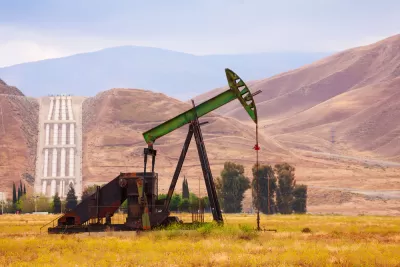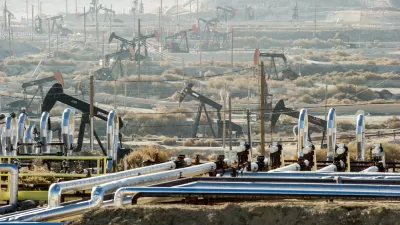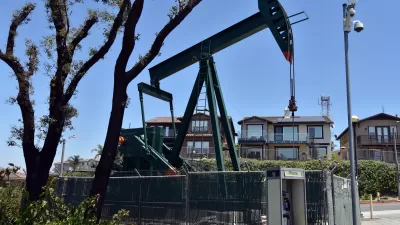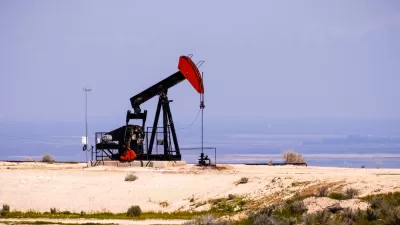Gov. Gavin Newsom pleased environmentalists by doing what his predecessor, Gov. Jerry Brown, refused – halting all new oil and gas fracking and placing a moratorium on another extraction method linked to a massive oil spill in Kern County.

"In a victory for critics of California’s oil drilling industry, Gov. Gavin Newsom on [Nov. 19] stopped the approval of new hydraulic fracturing in the state until the permits for those projects can be reviewed by an independent panel of scientists," reports Phil Willon for the Los Angeles Times.
It is one of three announced by the Department of Conservation’s Division of Oil, Gas and Geothermal Resources (DOGGR) on Nov. 19 affecting oil and gas extraction prompted by the passage of Assembly Bill 1057 by Assemblymember Monique Limón (D-Santa Barbara), which removes "oil and gas" from the name of the division. It will become known as the Geologic Energy Management Division, or CalGEM, effective Jan 1.
Its new mission, according to the legislation, will be "protecting public health and safety and environmental quality, including reduction and mitigation of greenhouse gas emissions associated with the development of hydrocarbon and geothermal resources in a manner that meets the energy needs of the state."
The second initiative "imposed a moratorium on new permits for steam-injected oil drilling, another extraction method opposed by environmentalists that was linked to a massive petroleum spill in Kern County over the summer," adds Willon. The drilling operator, Chevron, was ordered on Oct. 2 to pay a civil penalty of $2.7 million, reported Janet Wilson and Julie Makinen for the Palm Springs Desert Sun.
Four 'surface expression' spills – water, steam and oil forced to the surface — occurred in the field between May and July, Acting Oil and Gas Supervisor Jason R. Marshall found.
These types of spills (fact sheet [pdf]) can be fatal to oil workers in addition to harmful to the environment and public health.
Regulators said Chevron has told them the spills were likely as the result of cyclic steam operations. In this process, natural gas plants are put in an oil field to produce steam, which is blasted or poured down well holes to soften and dislodge the thick, gooey oil. The process is also known as "steam flooding."
It was one of the largest spills in the state's history, with 31,685 barrels (or 1.3 million gallons) of oil and water released in the surface expressions as of Aug. 1, according to California Office of Emergency Services (Cal OES). By comparison, the 1969 Santa Barbara offshore spill released 80,000 barrels of crude oil.
Don Drysdale, pubic affairs officer for the Department of Conservation, clarified in an email that the action on fracking permits is not a moratorium like the one imposed on high-pressure cyclic steam injection but a pause pending a review by division staff and the Lawrence Livermore National Laboratory.
He added that "independent experts from the Lawrence Livermore and Sandia National Laboratories are studying [cyclic steam injection wells] in the Cymric Oil Field in Kern County" where the surface expressions occurred. This form of extraction, which "accounts for roughly 5 percent of the state’s production," is more prevalent than "well stimulation, mainly hydraulic fracturing," which accounts for about 1 percent of the state’s production, he noted.
The third initiative is "to study the possible adoption of buffer zones around oil wells in or near residential neighborhoods, schools, hospitals and other facilities that could be exposed to hazardous fumes," adds Willon.
Preparing for phase-out of oil?
“These are necessary steps to strengthen oversight of oil and gas extraction as we phase out our dependence on fossil fuels and focus on clean energy sources,” said Governor Newsom in the announcement by the Department of Conservation. Natural Resources Secretary Wade Crowfoot, who oversees that department, reinforced that message that pleased environmentalists but no debt caused concern for oil workers and the oil industry.
“We are updating rules to better ensure that public health and safety are protected as we continue the transition away from carbon extraction to a renewable energy future,” said Crowfoot.
Should the focus be on oil production and/or consumption?
"Catherine Reheis-Boyd, president of the Western States Petroleum Assn., said California already has some of the most strict regulations and environmental protections in the world and that curtailing oil production in the state will have serious consequences," adds Willon.
"These agencies should also consider reliability, affordability and resilience of our energy supply, as every barrel delayed or not produced in this state will only increase imports from more costly foreign sources that do not share our environmental and safety standards.”
That warning is reminiscent of how Newsom's predecessor, Gov. Jerry Brown, responded to anti-fracking activists at an event in April 2017 in San Francisco.
"'As we bring down [oil] consumption, we can bring down [oil] production,' the governor said, but since California residents now drive about 330 billion miles a year, most of it in vehicles powered by gasoline or diesel, there’s a long way to go," reported John Wildermuth for the San Francisco Chronicle (posted here).
“California is only producing 30 percent of its oil,” Brown said. “The rest comes in ships, mostly, but increasingly in trains.”
Cutting the state’s oil production without cutting demand just means that more of California’s oil will come from other states or other countries, which may not have the strong restrictions on fracking and oil production that California now has.
“I don’t believe that makes sense,” Brown said.
However, Vox's energy and climate change reporter, David Roberts, expounded on the merits of supply-side climate policy last year, describing at least one study in support.
Supply & demand: fuel consumption increases while oil production decreases
Drysdale of the Department of Conservation noted in his email that California's oil production has been declining since 1985, while other states have been increasing production due to increased use of fracking. New Mexico, Oklahoma, and Colorado, in addition to long-time leaders Texas and North Dakota, now exceed California in production, according to the U.S. Energy Information Administration.
While Newsom acknowledged that "(t)his transition (away from oil) cannot happen overnight; it must advance in a deliberate way to protect people, our environment, and our economy," there was no recognition of the issue that both Brown and Reheis-Boyd raised – that reducing the state's oil production, which has been the case for almost 35 years, only makes the state's 15 oil refineries more reliant on tankers transporting crude oil from Alaska and overseas and more modest amounts from Canada and Western states by crude-by-rail.
Meanwhile, on the consumption end of oil, the latest report from Next 10, a nonprofit research group focused on California issues, finds that largely due to the state's inability to reduce emissions from transportation, "California will meet its 2030 climate targets more than three decades late—in 2061—and could be more than 100 years late in meeting its 2050 target [pdf] if the average rate of emissions reductions from the past year holds steady."
However, Newsom and the legislature appear to make reducing oil production as important as reducing fuel consumption. A budget bill directs the California Environmental Protection Agency to conduct two carbon neutrality studies on "Vehicle Emissions and Fossil Fuel Demand and Supply." The second one "will identify strategies to decrease the demand and supply of fossil fuels, while managing the decline of fossil fuel use in a way that is economically responsible and sustainable."
Environment reporter Julie Cart writes on the contradictory goals of federal and state permitting agencies in her Dec. 5 piece in CalMatters, "Battle lines are drawn over oil drilling in California."
Related in Planetizen:
-
Keep it in the Ground – 2018, September 10, 2018
-
Greener Gasoline to Come from Solar-Powered Oil Wells in California, December 4, 2017
Hat tips to Gary Lasky and Chris Gilbert.
FULL STORY: Newsom blocks new California fracking pending scientific review

Alabama: Trump Terminates Settlements for Black Communities Harmed By Raw Sewage
Trump deemed the landmark civil rights agreement “illegal DEI and environmental justice policy.”

Study: Maui’s Plan to Convert Vacation Rentals to Long-Term Housing Could Cause Nearly $1 Billion Economic Loss
The plan would reduce visitor accommodation by 25% resulting in 1,900 jobs lost.

Planetizen Federal Action Tracker
A weekly monitor of how Trump’s orders and actions are impacting planners and planning in America.

Waymo Gets Permission to Map SF’s Market Street
If allowed to operate on the traffic-restricted street, Waymo’s autonomous taxis would have a leg up over ride-hailing competitors — and counter the city’s efforts to grow bike and pedestrian on the thoroughfare.

Parklet Symposium Highlights the Success of Shared Spaces
Parklets got a boost during the Covid-19 pandemic, when the concept was translated to outdoor dining programs that offered restaurants a lifeline during the shutdown.

Federal Homelessness Agency Places Entire Staff on Leave
The U.S. Interagency Council on Homelessness is the only federal agency dedicated to preventing and ending homelessness.
Urban Design for Planners 1: Software Tools
This six-course series explores essential urban design concepts using open source software and equips planners with the tools they need to participate fully in the urban design process.
Planning for Universal Design
Learn the tools for implementing Universal Design in planning regulations.
Caltrans
Smith Gee Studio
Institute for Housing and Urban Development Studies (IHS)
City of Grandview
Harvard GSD Executive Education
Toledo-Lucas County Plan Commissions
Salt Lake City
NYU Wagner Graduate School of Public Service





























